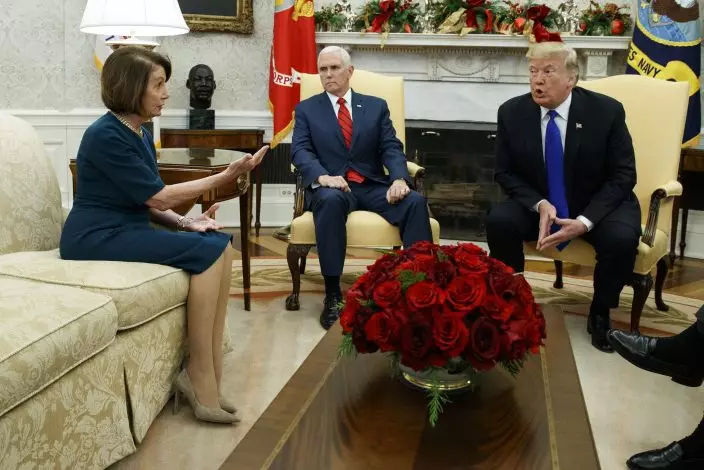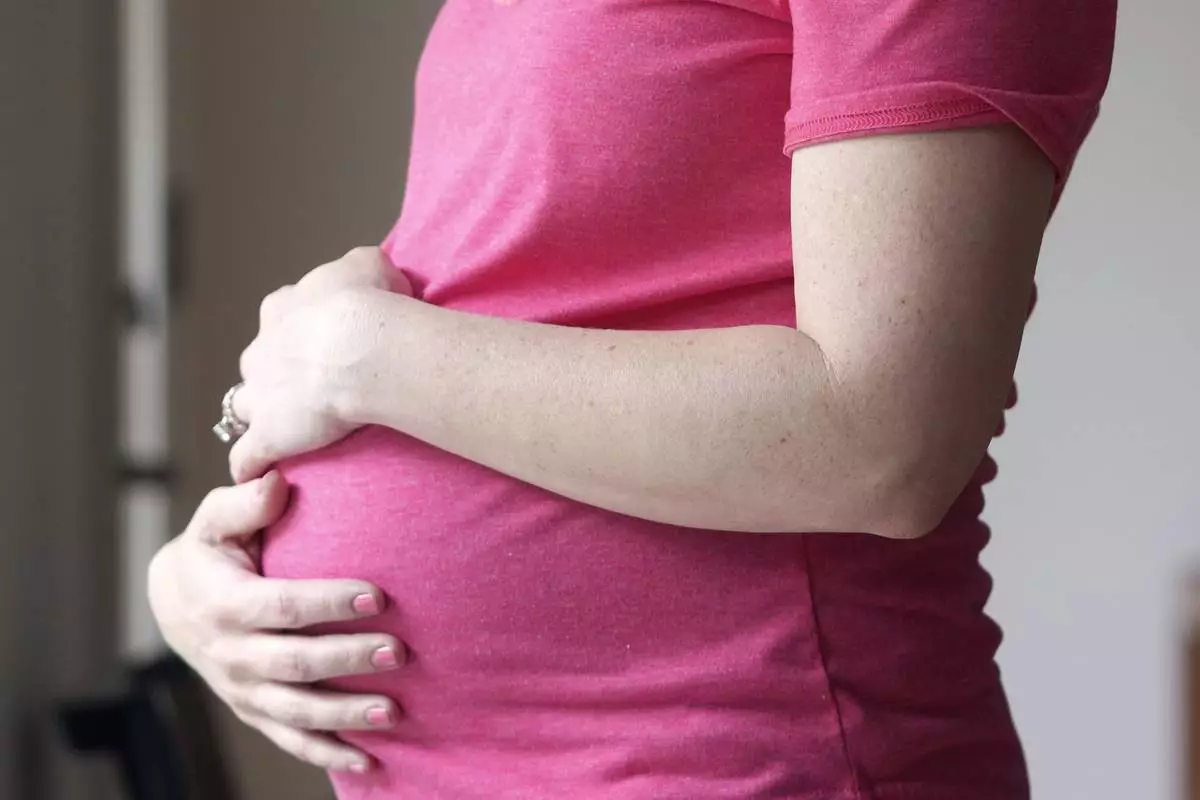The heated, on-camera Oval Office exchange between House Minority Leader Nancy Pelosi, Senate Minority Leader Chuck Schumer and President Donald Trump was an extraordinary public airing of grievances, with lots to unpack. What was being said between the lines? And who was blurring facts?
TRUMP: "One thing that I do have to say is tremendous amounts of wall have already been built, and a lot of wall when you include the renovation of existing fences and walls renovated a tremendous amount, and we've done a lot of work. In San Diego we're building new walls right now. And we've — right next to San Diego, we've completed a major section of wall, and it's really worked well. So a lot of wall has been built. We don't talk about that, but we might as well start because it's being built right now. Big sections of wall. And we will continue that. And one way or the other it's going to get built.
FACT CHECK: Tremendous portions of the wall have not been built. Yes, some barrier renovation has happened, but little wall construction has been completed under Trump. Congress allocated roughly $1.4 billion in the spring for border security, but it specified that the money couldn't be used to construct new border wall in the style of prototype sections that stand near San Diego. Instead, the money has been used to strengthen or replace existing fencing with more secure fencing.

Vice President Mike Pence, center, looks on as House Minority Leader Rep. Nancy Pelosi, D-Calif., and President Donald Trump argue during a meeting in the Oval Office of the White House, Tuesday, Dec. 11, 2018, in Washington. (AP PhotoEvan Vucci)
During his campaign, Trump promised to build a 1,000-mile (1,600 kilometer) wall, as high as 40 feet or 12 meters (and have Mexico pay for it). If some 650 miles (1,050 km) of existing fencing are considered in the equation, that leaves him with about 350 miles (560 km) of wall to build.
PELOSI: I think the American people recognize that we must keep government open, that a shutdown is not worth anything, and that you should not have a Trump shutdown. You have a ....
(CROSSTALK)
TRUMP: A what? Did you say "Trump?" Oh. I was going to call it a Pelosi shutdown.
FACT CHECK: Pelosi is clearly egging Trump on with the cameras rolling. In January, Trump branded a shutdown the "Schumer Shutdown" — and Democrats relented after only a few days. Pelosi is using Trump's own tactic against him.
TRUMP: Nancy, I'd have it passed in two seconds. It doesn't matter though, because can't get it passed in the Senate because we need 10 Democrat votes. That's the problem.
PELOSI: Well, again, let us have our conversation then we can meet with the press again. But the fact is that legislating, which is what we do, you begin, you make your point, you state your case. That's what the House Republicans could do if they had the votes. But there are no votes in the House, a majority of votes, for a wall ... Let me — let me say one thing. The fact is that you do not have the votes in the House.
TRUMP: Nancy, I do, and we need border security.
PELOSI: Well, let's take the vote and we'll find out.
FACT CHECK: The GOP-led House has yet to pass legislation that includes the $5 billion in border wall funding that Trump has been requesting. And it remains unclear whether Republican House Speaker Paul Ryan does indeed have the votes. House Republicans tend to lack votes for spending bills. Thanks to resistance from members of the House Freedom Caucus and other conservatives, they are often forced to rely on Democratic support for passage. There is also a handful of House Republicans, some hailing from border states, who oppose robust wall spending. It's unclear how many Republicans who lost their re-elections will choose to stick around for holiday-season votes. And even if it could pass the House, Ryan has said he has no interest in putting such a plan forward because it would be dead on arrival in the Senate.
TRUMP: We need border security. People are pouring into our country, including terrorists. We have terrorists. But we caught 10 terrorists. These are over the last very short period of time — 10. These are very serious people. All of our law enforcement have been incredible, but we caught 10 terrorists, these are people that were looking to do harm. We need the wall. We need — more important than anything, we need border security of which the wall is just a piece, but it's important.
FACT CHECK: Trump appears to be conflating statistics as Vice President Mike Pence has previously and wrongly suggesting the terror suspects he's referencing were caught attempting to cross the southern border.
U.S. Customs and Border Protection last year prevented an average of 10 known or suspected terrorists flagged by terror watch lists from traveling or attempting to travel to the country each day. But that average applies to all points of entry, not just the southern border, including air, land and sea.
The administration has also provided no public information to support Trump's previous claim that Middle Easterners, apparent code for Islamic extremists, have infiltrated caravans of Central Americans who were traveling in caravan and trying to reach the U.S.
TRUMP: And we gained in the Senate. Nancy, we've gained in the Senate. Excuse me, did we win the Senate? We won the Senate.
(CROSSTALK)
SCHUMER: When the president brags that he won North Dakota and Indiana, he's in real trouble.
TRUMP: I did. We did. We did win North Dakota and Indiana.
FACT CHECK: Trump has repeatedly complained that he hasn't been given enough credit for the fact that Republicans maintained control of the Senate in last month's midterm elections — even though they lost control of the House. Schumer here is pointing to the fact that both North Dakota —where Rep. Kevin Cramer beat incumbent Democratic Sen. Heidi Heitkamp — and Indiana — where Republican Mike Braun unseated Democrat Joe Donnelly— are considered Republican states, where Democratic candidates were especially vulnerable.
TRUMP: I also know that, you know, Nancy's in a situation where it's not easy for her to talk right now, and I understand, and I fully understand that. We're going to have a good discussion, and we're going to see what happens. But we have to have border security.
PELOSI: Mr. President — Mr. President, please don't characterize the strength that I bring to this meeting as the leader of the House Democrats, who just won a big victory.
SCHUMER: Elections have consequences, Mr. President.
FACT CHECK: Trump is referring to Pelosi's fight to regain her position as House speaker next year. Pelosi is the Democratic nominee for the post, but she has yet to lock down the 218 votes she'll need to win. Trump appears to suggest that Pelosi is only holding a hard line on the border wall in order to win votes from more liberal members of her caucus. But Pelosi responds by scolding him and pointing to the fact that Democrats won the House in the midterm elections and will be taking control next year.
TRUMP: And I'll tell you what, I am proud to shut down the government for border security, Chuck, because the people of this country don't want criminals and people that have lots of problems, and drugs pouring into our country.
So I will take the mantle. I will be the one to shut it down. I'm not going to blame you for it. The last time you shut it down it didn't work. I will take the mantle of shutting down, and I'm going to shut it down for border security.
SCHUMER: But we believe you shouldn't shut it down.
FACT CHECK: Under the usual rules of politics, neither party, Republican nor Democrat, wants to be blamed for a government shutdown, especially once popular services are stalled or interrupted. Both sides have been damaged by shutdowns before, including Republicans in 2013 and Democrats in 2018.
But Trump here is throwing that aside, banking that forcing a shutdown over his long-stalled border wall will earn him points with his base and show them he's fighting hard to keep a key campaign promise that will be even harder to fulfill once Democrats take charge of the House in January.
Pelosi later crowed about the moment in a closed-door session with Democratic House members, in which she also described the wall as "like a manhood thing" for Trump.
But other top Republicans, including Senate Majority Leader Mitch McConnell, are trying to avoid ownership of any shutdown, and have made clear they won't be proud if another takes place.
Associated Press writers Lisa Mascaro and Calvin Woodward contributed to this report.










